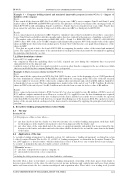Page 429 - SAIT Compendium 2016 Volume2
P. 429
IN 43 (5) Income Tax acT: InTeRPReTaTIon noTes IN 43 (5)
Example 3 – Company holding tainted and untainted immovable property [section 9C(3)(a)] – Impact of liabilities of the company
Facts:
Z has owned all the shares in ABC (Pty) Ltd (ABC) for ten years. ABC’s assets comprise Stand 1 and Stand 2, with market values of R400 000 and R600 000 respectively. The purchase of Stand 2 was nanced by a mortgage bond, of which R350 000 is still outstanding. Stand 1 is debt free. Stand 1 has been owned for four years, while Stand 2 has been owned for only three months. Z disposed of all the shares in ABC to a third party for R650 000.
Result:
Z is a connected person in relation to ABC. Stand 1 is ‘untainted’ since it has been held for at least three consecutive years. Stand 2 has been held for only three months and is, therefore, tainted for the purposes of applying section 9C(3).
The market value of both properties is R400 000 (40% – Stand 1) + R600 000 (60% – Stand 2) = R1 000 000 (100%). Since 60% of the assets of ABC comprise tainted immovable property, 60% of the market value of the equity shares in ABC derive their value from such property. Section 9C(2) will, therefore, not apply when Z disposes of the shares in ABC.
Note that no regard is had to the bond of R350 000 in comparing the market values of the tainted and untainted assets. The capital or revenue nature of the amount derived on disposal of the shares must be determined by applying the principles laid down by case law.
7.2.2 Bare dominium scheme
Section 9C(3)(b) applies when –
• the company in which the qualifying shares are held, acquired any asset during the continuous three-year period
immediately before the disposal; and
• rentals in respect of that asset were paid or payable to a person other than the company for the use of that asset while
that asset was held by that company during the three-year period.
Example 4 –Bare-dominium scheme [section 9C(3)(b)]
Facts:
K has owned all the equity shares in XYZ (Pty) Ltd (XYZ) for ve years. At the beginning of year 5 XYZ purchased the bare dominium in a luxury at for R2 million, fully funded by a mortgage bond. The seller of the at retained the lease rights for ten years. XYZ’s other assets comprise share investments and cash worth R4 million, funded by a shareholder’s loan account. The bare dominium has a market value at the end of year 5 of R3,5 million. K sells the shares in XYZ at the end of year 5 for R1,5 million and cedes the loan account for its face value of R4 million.
Result:
K is a connected person in relation to XYZ. Section 9C(3)(a) does not apply because R4 million of XYZ’s assets of R7,5 million comprise untainted assets. However, section 9C(3)(b) applies because the bare dominium was acquired within three continuous years of the date of disposal of the shares and the lease rentals were receivable by a person other than XYZ. Section 9C(2) will, therefore, not apply when K disposes of the shares in XYZ. The capital or revenue nature of the amount derived on disposal of the shares must be determined by applying the principles laid down by case law.
8. Securities-lending arrangements [section 9C(4)] 8.1 The law
Section 9C(4)
8.2 Application of the law
A ‘securities lending arrangement’ is de ned in section 1(1) and means a ‘lending arrangement’ as de ned in section 1 of the Securities Transfer Tax Act No. 25 of 2007. A ‘lending arrangement’ as de ned in the Securities Transfer Tax Act, 2007 applies to a ‘listed security’, which is de ned in section 1 of that Act as ‘any security listed on an exchange’. A ‘security’ is de ned in the same Act under section 1 as follows:
In reality when a share is lent under a securities lending arrangement, ownership of the share passes from lender to borrower upon delivery of the share. In order to prevent income inclusions and capital gains and losses from arising under such transactions, the Act contains non-disposal and acquisition rules. These rules cover trading stock [section
(4) For purposes of this section, where—
(a) any share has been lent by a lender to a borrower in terms of a securities lending arrangement, such share shall for the purposes of the lender be deemed not to have been disposed of by the lender; and
(b) any other share of the same kind and of the same or equivalent quantity and quality has been returned by the borrower to the lender, such share and such other share shall be deemed to be one and the same share in the hands of the lender.
‘[S]ecurity’ means—
(a) any share or depository receipt in a company; or
(b) any member’s interest in a close corporation,
(c) . . . .
excluding the debt portion in respect of a share linked to a debenture;
saIT comPendIum oF Tax LegIsLaTIon VoLume 2 421


